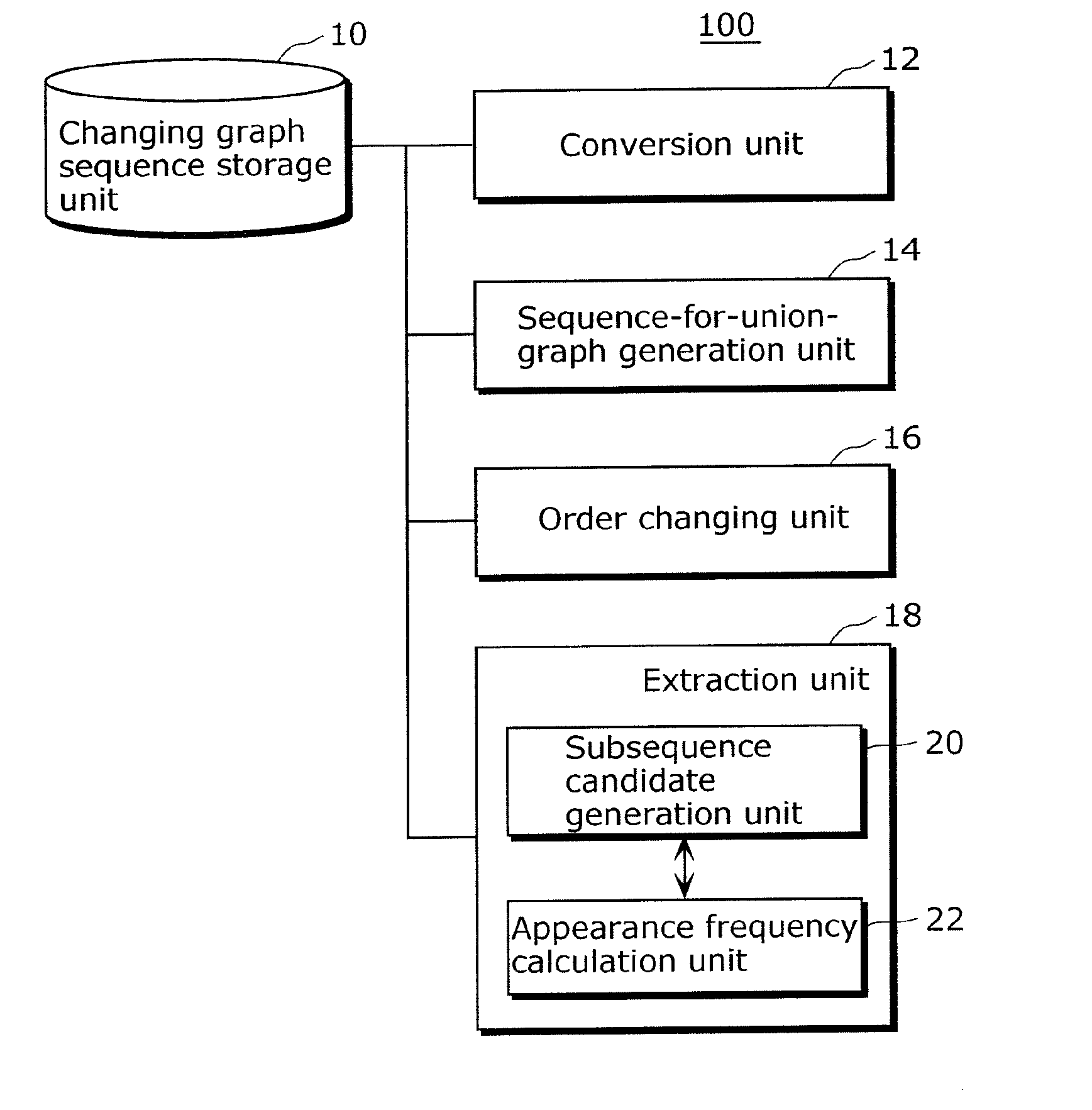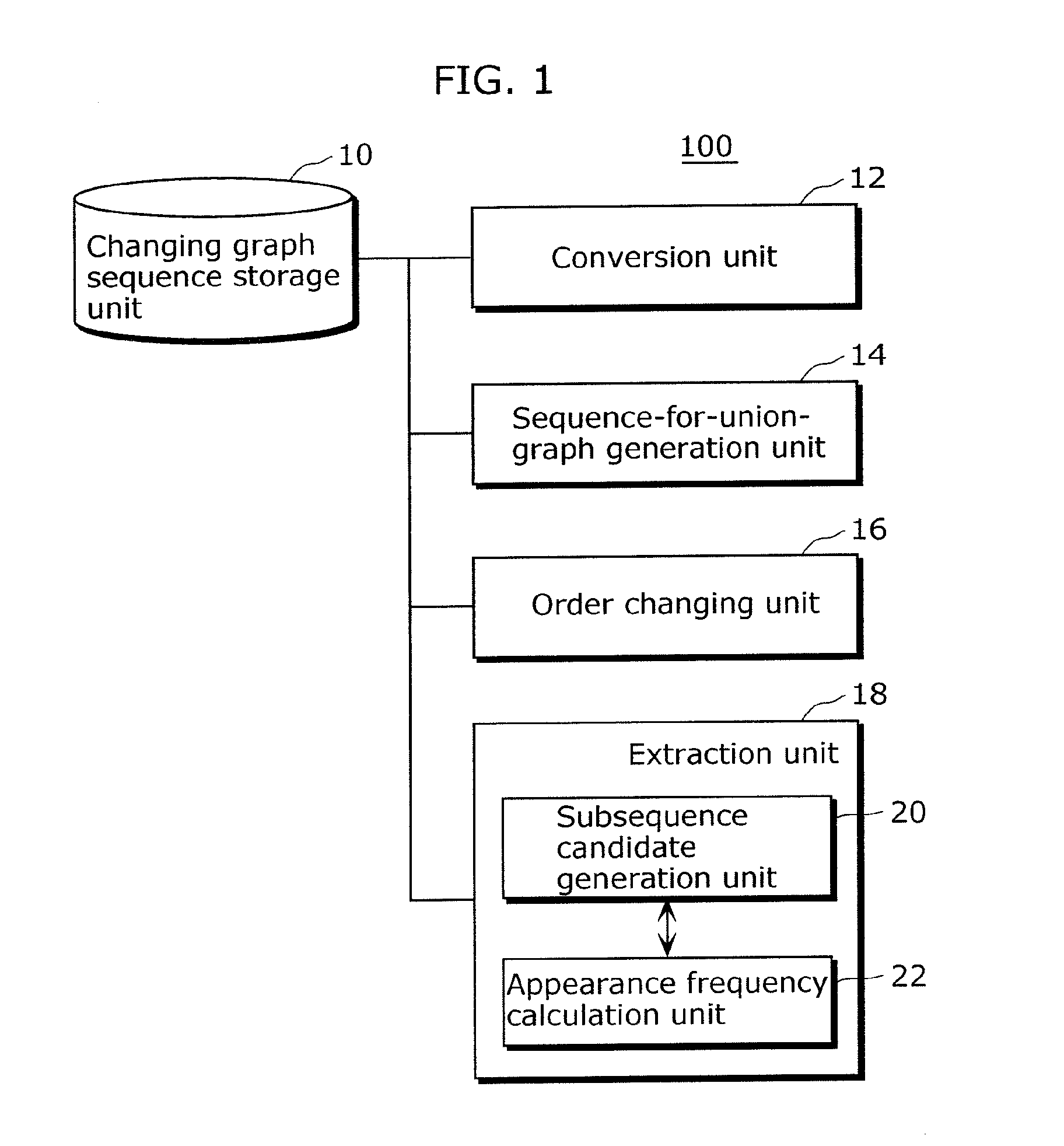Frequent changing pattern extraction device
a pattern extraction and frequency technology, applied in the field of data mining techniques, can solve problems such as difficult definition
- Summary
- Abstract
- Description
- Claims
- Application Information
AI Technical Summary
Benefits of technology
Problems solved by technology
Method used
Image
Examples
example 1
[0066]A network of webpages has a graph structure where a vertex corresponds a webpage and an edge corresponds to a hyperlink, for example. The graph structure changes whenever an edit is performed. For instance, g(t) has a graph structure in the t-th phase of a certain website. Although each page may be considered to be unlabeled, it may also be considered to be labeled such as “Webpage of University”, “Webpage of Financial Company”, or “Webpage of Manufacturing Company”. A label is set according to the intention of analysis, and is not specifically designated in the present invention.
[0067]A union graph is defined in order to discuss what kind of pattern is to be searched for. Each vertex vi of a graph has a unique ID id (vi) that does not change over time. In the aforementioned examples of webpages, URLs correspond to the unique IDs. When a set of graphs expressed as {g1, . . . , gn} is given, Math. 7 described below is defined by Math. 8 as follows.
G=∪igi [Math. 7]
V(G)=∪i{id(v)...
example 2
[0079]A sequence shown in FIG. 4 is considered, for instance. The sequence shown in FIG. 4 can be expressed by a sequence of insertions and deletions of vertices and edges as shown in FIG. 5. A numerical superscript assigned to each individual vertex represents the unique ID of the vertex. Here, the changes in the graphs can be expressed as follows.
g(2)=OP[ei,(1,2),-](1)OP[vi,3,C](1)OP[vd,1,A](1)OP[ed,(1,2),-](1)OP[ei,(1,2),-](0)OP[vi,2,C](0)OP[vi,1,A](0)⊥[Math.14]
When the data di in the database is expressed as di=i(1) gi(2) . . . gi(n)>, this expression is referred to as the graph sequence representation.
g(n)=OP[*, ok, lk](n−1) . . . OP[*, o1, l1](0) OP[*, o0, l0](0)⊥ [Math. 15]
When expressed as the above, this expression is referred to as the transformation operator representation.
OP[*, o0, l0](0) . . . OP[*, ok, lk](n−1) [Math. 16]
When expressed as the above, this expression is referred to as the transformation operator sequence representation. Suppose that an operator express...
example 3
[0129]Suppose that a scaffold sequence s and sequence data di are expressed by the following equations respectively in the transformation operator sequence representation.
s=〈OP[vi,1,A](1)OP[vi,2,B](2)OP[ei,(1,2),-](2)OP[vi,3,C](3)OP[ei,(2,3),-](3)〉seq(di)=〈OP[vi,1,D](1)OP[vi,2,A](1)OP[ei,(1,2),-](1)OP[vi,3,B](2)OP[ei,(2,3),-](2)OP[ed,(2,3),-](3)OP[ei,(1,3),-](3)OP[ed,(1,2),-](4)OP[vd,2,A](4)OP[vi,4,C](4)OP[ei,(3,4),-](4)OP[vi,2,B](5)OP[ed,(3,4),-](5)OP[ei,(1,4),-](5)〉[Math.55]
[0130]Here, project ((tidi, di), s) is expressed as follows.
[Math.56]project((tidi,di),s)={(tidi,〈OP[vi,2,A](1)OP[vi,3,B](2)OP[ei,(2,3),-](2)OP[ed,(2,3),-](3)OP[vd,2,A](4)OP[vi,4,C](4)OP[ei,(3,4),-](4)OP[vi,2,B](5)OP[ed,(3,4),-](5)〉)}(4)
[0131]The sequence (4) is expressed as follows when the operators having the same application order t are parenthesized and t is thus removed.
OP[vi, 2, A](OP[vi, 3, B]OP[ei, (2, 3), −])OP[ed, (2, 3), −](OP[vd, 2, A]OP[vi, 4, C]OP[ei, (3, 4), −])(OP[vi, 2, B]OP[ed, (3, 4), −]) [...
PUM
 Login to View More
Login to View More Abstract
Description
Claims
Application Information
 Login to View More
Login to View More - R&D
- Intellectual Property
- Life Sciences
- Materials
- Tech Scout
- Unparalleled Data Quality
- Higher Quality Content
- 60% Fewer Hallucinations
Browse by: Latest US Patents, China's latest patents, Technical Efficacy Thesaurus, Application Domain, Technology Topic, Popular Technical Reports.
© 2025 PatSnap. All rights reserved.Legal|Privacy policy|Modern Slavery Act Transparency Statement|Sitemap|About US| Contact US: help@patsnap.com



